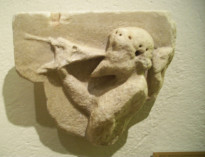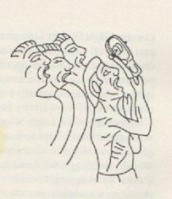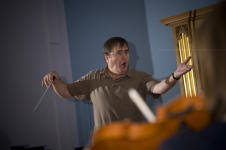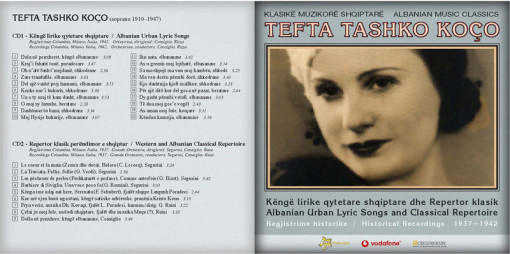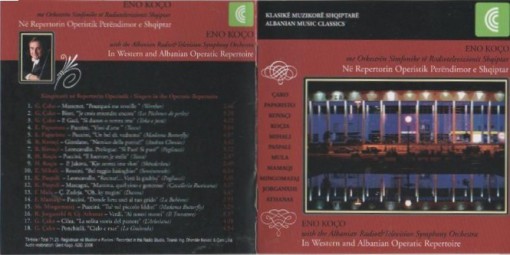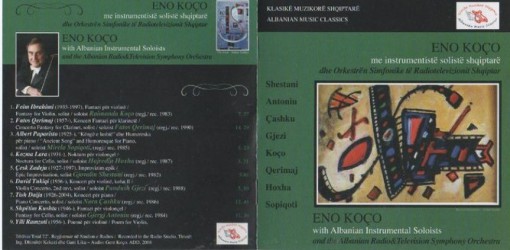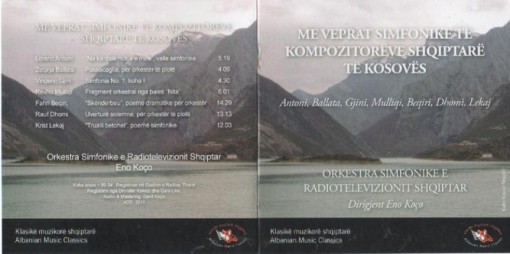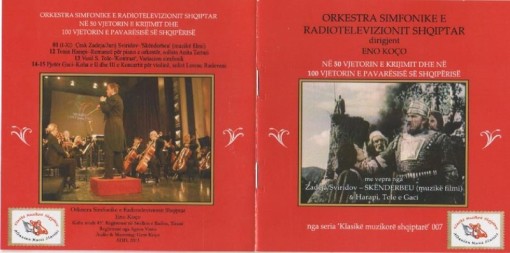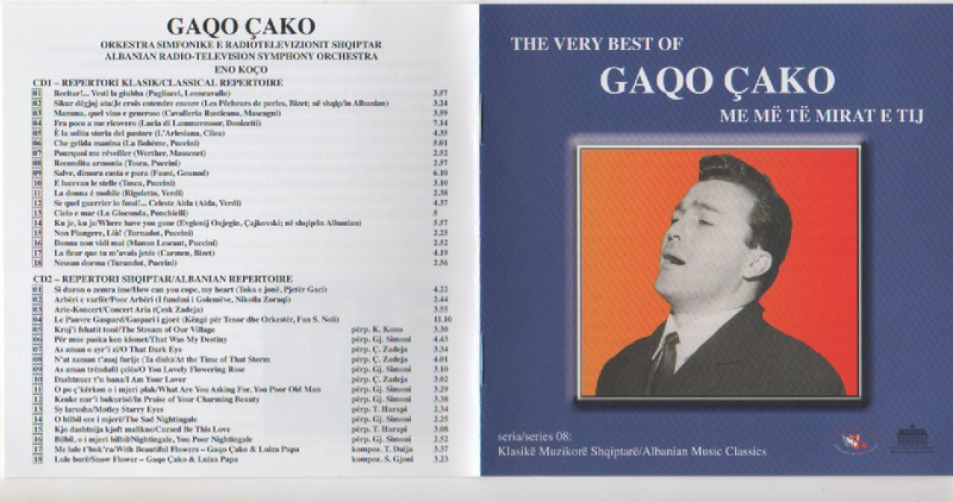Any of the CDs below can be purchased through Paypal with payment directed to enokoco1@hotmail.com. Once we have received confirmation your CD(s) will be sent out directly. Please insert the title of your chosen CD(s) into the Paypal message box along with your postal address and email address before confirming your purchase.
Tefta Tashko Koço in Albanian Urban Lyric Songs and Classical Repertoire
Soprano Tefta Tashko Koço (1910-1947) was born in Fayoum, Egypt, where her parents had emigrated from the end of the 19th century. In 1921 the family moved to Korçë, and in 1927 Tefta left for Montpellier to learn singing. Between 1932 and 1936 she studied at the Conservatoire National de Musique et de Déclamation in Paris. When she returned to Albania permanently in 1936, apart from her programmes of operatic and chamber music, she also dedicated a great deal of effort to concentrating on learning and performing the Albanian urban lyric songs.
When urban songs began to enter the classical repertories, the pioneers of the vocal art in Albania skilfully tried to develop them into urban lyric songs, by bringing to them new forms and shapes. Using the urban singerʼs repertoire which belonged to his or her personal world, enriching it and elaborating it into a public declamation by soprano, tenor and baritone voices, the Albanian urban songs adopted from art singing the facility to produce a more elegant melodic line. The process which created this genre in the 1930s continued in later decades with added interest and commitment from the singer as well as from the creator.
Art Music in Albania from the First Half of the Twentieth century
The seeds of a distinctively national art music in Albania are usually dated from the second half of the Twentieth century. However, there were musicians and composers who worked with a national conciseness advocating the Albanian musical culture before the post-war era. Having been interested for many years in Pre-WWII Albanian orchestral music, I made the first-ever recordings of several Albanian works with the Albanian Radio and Television Symphony Orchestra between 1978 and 1991, while I was its permanent conductor. The recorded pre-war repertoire included the Symphony, Two Flowers on Scanderbeg’s Grave, by Martin Gjoka (1932), the Albanian Rhapsody by Murat Shehu (1937), the tone poem Scanderbeg, a song for tenor and orchestra Le Pauvre Gaspard, the Albanian Rhapsody and Byzantine Overture by Fan S. Noli, the last four written in Boston, in 1937.
The Symphonic Music of Four Albanian Composers: Çesk Zadeja (1927-1997), Tish Daija (1926-2004), Tonin Harapi (1928-1992) and Gjon Simoni (1936-1999).
The symphonic music featured in the present CD comprises four Albanian composers originally from Shkodra: Çesk Zadeja (1927-1997), Tish Daija (1926-2004), Tonin Harapi (1928-1992) and Gjon Simoni (1936-1999).
A brief panorama of Shkodra art music: The three main inclinations with their representatives which could be classified as embodying the traits of the art music of Shkodra are: the mountainous music based on the motifs of the Mbi-Shkodër (Highlands) region and further east (Martin Gjoka, Çesk Zadeja and Tish Daia), the urban music based on the Shkodran aheng and the shtregulla and wedding songs (Tonin Harapi), and the Western inclined music based on melodic and harmonic romantic European tradition (Lec Kurti, Mikel Koliqi and Prenk Jakova). The above mentioned tendencies, which in themselves constitute a heritage, continue to this day in the same orientation and with equal dedication. Which of these three inclinations carry more musical value or are truly adopted by the surrounding people, only time will tell. As I had the privilege to know on a personal level all of the protagonists in this CD, I was in a position to get engaged in their creative process, in general, and the works included on this CD, in particular.
Albanian Singers in Western and Albanian Operatic Repertoire
In the late 1970s the recording of the solo vocal repertoire was a relatively new experience for the Albanian Radio&Television Symphony Orchestra and for me; we were still recording on MONO and there were several deficiencies relating to the schemes of setting up microphones and the balancing of instruments. With the recordings of Gaqo Çako came a period of more frequent vocal recordings involving other singers too, thus they represent, in a way, a new development in this field. The recordings of the 1970s and 80s coincided with a period where the translation into Albanian of all foreign operas was imposed by the regime. However, despite this ideological inclination, an Albanian translation helped in the understanding of the operatic text and was certainly appreciated by the public; several arias of this CD are translated into and sung in Albanian.
Albanian Art Music with Albanian Instrumental Soloists
The recordings represented on this CD, which comprise nine Albanian composers, are made by Albanian instrumental soloists playing five different musical instruments: violin, piano, cello, clarinet and flute. Since the main focus of the instrumental recordings are the performers and not the composers, the latter are represented here selected by the preferences of the instrumentalists. Their chosen works were inclined to suit the performers’ tastes and musical expressions and to reflect very direct musical connection between their aesthetic approaches and composer’s styles. The soloists display different approaches to musical concepts and performances. Being the best instrumental soloists of the time they were able of subtle and fine distinctions of sound within an expressive vocabulary of performances of the chosen instrumental compositions. There is a popular notion that performers have more knowledge of and sympathy with composers who are their fellow nationals. The emphasis on certain Albanian ‘regional’ and modal expressive devices as an expression of the performer’s native musical idiom is found almost in each particular recorded piece.
Albanian Art Music with Albanian Instrumental Soloists
Reflections on meetings with Kosovan composers and their works - In 1978 for the first time I was introduced to two people from Kosova, the composer Rauf Dhomi and his wife, Ajmone, both of them appeared to be genuine intellectuals. They also for the first time paid a visit toAlbania. Limos Dizdari and I became their companions and the four of us stayed together in Tirana and travelled around the country. Both parts, them and us, hesitated in starting an open and frank conversation and continued for some time to be cautious and act like foreigners. However, I felt that they were more relaxed than us, although we were in our own country. I could not believe that they could speak so good Albanian, of course in their own dialect. This surprised me a lot. It was this episode that made me get interested in Kosova in general and in their art music in particular. The first printed scores that I had the chance to see made a deep impression on me; they were beautifully bound and among them was the ‘Five Musical Works’ by Lorenc Antoni.
As the conductor of the Albanian Radio&Television Symphony Orchestra at the time I was able to perform and even make studio recordings of the two orchestral dances, such as “The Mountain Maid” and “It came out to be a good bride”. The latter one it is included on this CD (Track 1).
Kosovar Art Composers
Muzika e filmit 'Skënderbeu' u ekzekutua për herë të parë në Shqipëri nën drejtimin tim pas afro gjashtëdhjetë vjetësh të regjistrimit të saj në studion e Moskfilm-it. Kjo për arsyen sepse partiturat muzikore të saj kishin mbetur në Moskë dhe posedimi i tyre ishte bërë krejësisht i pamundur. Regjistrimi i kësaj muzike në këtë CD është realizuar drejtpërsëdrejti nga salla duke përbërë kështu premierën absolute në Shqipëri si ekzekutim dhe regjistrim. Vlen të përmendet se shqiptarët e kishin dëgjuar pafundësisht këtë muzikë nëpërmjet filmit 'Skënderbeu' por edhe transmetimeve në vite të Radio Tiranës falë regjistrimit të bërë më 1953 nga Orkestra e Kinematografisë së Moskës me dirigjent G. Gamburg.

